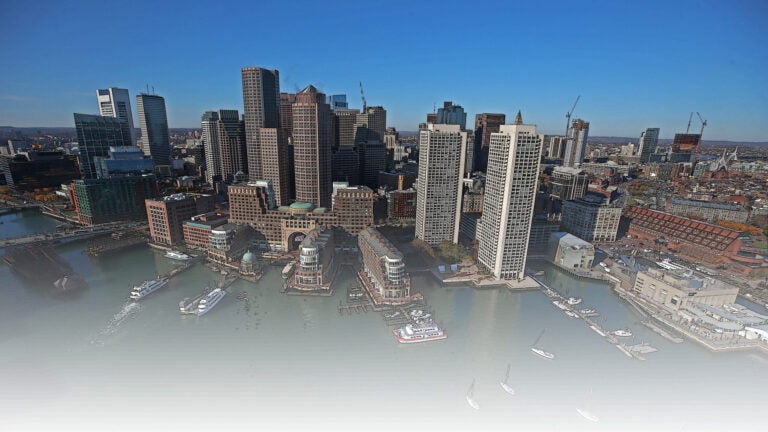Is Boston losing its mojo? Experts say renters are growing open to, but may not be ready, to leave
Census estimates show that Massachusetts actually lost people in the 12 months ending July 1, 2020, for the first time since 2005.

Blame the housing prices or the cold, but for the first time in living memory, Boston no longer ranks among the top 10 most populous metro areas in the United States. We were bumped to No. 11 by the fast-sprawling Phoenix area.
In fact, after a decade of slow but steady growth, Census estimates released last month show that Massachusetts actually lost people in the 12 months ending July 1, 2020, for the first time since 2005. (In New England, only Maine and New Hampshire added residents in that time.) And while the Bay State’s population grew by about 5 percent from 2010 to 2020 — more than every other Northeastern state — that was still below the national average of 6.5 percent. Southern and Western states have seen the fastest growth, with Arizona, Colorado, Florida, Idaho, Nevada, Texas, Utah, and the District of Columbia all seeing population surges by 15 percent or more in the past decade.
“The data really show that, if not for international migration, we actually would have been losers of population,’’ said Luc Schuster, director of the Boston Foundation’s Boston Indicators project. “We are losing some residents to other parts of the country with strong economies and better weather — which is one of the factors, certainly — and cheaper housing.’’
While international immigration declined slightly in each year of the Trump administration, it all but ceased in 2020 due to the coronavirus pandemic — meaning Massachusetts may have lost even more residents last year, though we won’t know for sure until full 2020 data are released. On top of that, Boston is missing thousands of college students who decided to defer admission or study remotely this fall due to COVID concerns. That’s left hundreds of extra apartments sitting empty, leading to a sharp drop in rents.
“From March through December, rents in Boston [proper] fell by 20.6 percent, which is the third-steepest decrease of any of the 100 largest cities in the country,’’ said Chris Salviati, a housing economist at the rental website Apartment List. Only San Francisco and Seattle saw deeper declines, and Salviati said it’s not clear that rents in expensive cities have hit bottom yet.
(Where are rents rising and falling in Central and Eastern Massachusetts? Check out our running list of the cost to rent in nearly a dozen communities.)
It raises a question that some were asking even before the pandemic: Is Greater Boston at risk of losing its longtime magnetism as would-be residents choose less expensive, warmer locales?
It’s not that people don’t want to move to or stay in Boston, Schuster said. “The fact that we had rapidly rising housing costs leading up to the pandemic shows that people want to live here — housing costs rise when people want to live in a place,’’ he said. “We just haven’t built enough new housing to accommodate the people who want to live here.’’
That’s a big reason we could lose residents to fast-growing southern cities like Charlotte, N.C., or Austin, Texas. “It’s hard for middle-class families to make ends meet here compared to those metro areas that are offering good jobs, better weather, and cheaper housing because they’re building more,’’ Schuster said.
Whether or not renters are actually bailing on Boston, they are increasingly open to the idea, said Al Norton, rental manager at Unlimited Sotheby’s International Realty in Brookline. Norton chalked it up to “the high price of mediocrity,’’ as rents, even outside the city, have risen without a corresponding increase in quality.
Time was, Norton said, if someone couldn’t afford the place they wanted in Cambridge or Newton, they could find something in, say, Medford or Watertown. “And what I’ve seen over the past couple of years is people saying, we’re having a hard time finding the quality we want at the price we want, even if we expand the map and the radius of our search,’’ he said. Meeting two out of three criteria is a reasonable compromise for most. “[But] once you’re down to one of the three? You start to reconsider and say, how much do we really need to be here?’’
Mark Perry, an economist at the American Enterprise Institute, a conservative think tank, maintains that it’s not just less expensive housing, but lower tax burdens and business-friendly policies that are drawing both companies and their workers from the Northeast to the Sun Belt.
Perry compared states with the most inbound migration in 2019 with those with the most outbound movers — Massachusetts among them — using measures of economic performance, business climate, individual and corporate tax burdens, and electricity and housing costs, among others. “There is empirical evidence that Americans and businesses ‘vote with their feet’ when they relocate from one state to another,’’ Perry determined, “choosing fiscally sound states that are more economically vibrant, dynamic, and business-friendly, with lower tax and regulatory burdens, lower energy and housing costs, and more economic and job opportunities.’’
‘It’s hard for middle-class families to make ends meet here compared to those metro areas that are offering good jobs, better weather, and cheaper housing because they’re building more.’ Luc Schuster, Boston Foundation
Aside from high housing and electricity costs, however, Massachusetts doesn’t quite fit what Perry calls “a predictable pattern’’ of stagnation among states losing the migration tug-of-war. In 2019, Massachusetts had one of the lowest unemployment rates in the United States — better than nine of the top 10 inbound states — and ranked in the middle of the pack in terms of tax burden and business climate.
One tax haven does draw a fair share of Bay Staters, however. Schuster analyzed the Census migration data and found that, while more than 11,700 people relocated from New Hampshire to Massachusetts in 2019, about 18,700 moved in the opposite direction — creating a net outflow of nearly 7,000 residents to the Granite State. We lost about 6,700 net residents to Florida and nearly 5,000 apiece to Rhode Island and California. Other states poaching our population in 2019 included Colorado, Texas, Vermont, Virginia, North Carolina, and Arizona.

Historically, Salviati said, a region’s local economy tends to be the main driver behind people’s decisions to live there. “For most people, their housing choice is pretty inextricably tied up with their labor market choice, so where you’re employed is where you’re going to live,’’ he said. The widespread shift toward remote work that we’ve seen during the pandemic could upend that relationship, however. “If there’s a large segment of the workforce that can now choose to live wherever they want, regardless of where their job is located, that could definitely have some interesting implications for housing markets across the country.’’
Even in such a scenario, though, Salviati expects many people would simply move to less expensive but nearby metros, where they can still get into the office with relative ease once a month for meetings or to make a presentation — something Apartment List data already appear to show, with rents rising in central California metros within a few hours of the Bay Area or Los Angeles.
“Pre-pandemic, one of the trends that we were looking at was this big rise in ‘super commuters,’ folks that were driving 90-plus minutes to the office,’’ Salviati said. “And one thing that you could imagine is in that primarily remote scenario, your radius for where you’re willing to make that occasional commute from maybe expands a bit.’’
Among Boston-area users searching for a rental unit on Apartment List from July to November, 29 percent were looking outside Greater Boston — but not far outside it. Almost a quarter of those searches were within New England, including 7.8 percent in Providence, 5.2 percent in Worcester, and 5.8 percent in New Hampshire. Those looking to move outside New England, meanwhile, weren’t exactly targeting low-cost areas so much as dynamic coastal cities like New York (7.5 percent), Washington (5.8 percent), and Los Angeles (5.1 percent).
Schuster agreed that even a permanent shift toward remote work wouldn’t doom the Boston area. “It’s possible, and we’ve already seen some of this, that you’ll just see more people move to other communities within the region,’’ he said, which could take some pressure off Boston’s high prices and help revitalize outlying cities. And if rents remain soft downtown, that could open up the city to a wider, more diverse swath of residents and small businesses who have been priced out for years.
Norton said that, while college students and recent graduates are the gas for the city’s rental engine, a lot of early summer leases revolve around medical residents, who are still coming in droves. He expects that will help stabilize the city’s June and July leasing period. “It’s one thing if you just graduated law school and you’re choosing between where you want to take your first law firm job,’’ he said, “but medical students who are starting residency programs don’t have that luxury — they’re told where they’re going to go. And we’ve got a lot of hospitals.’’
Still, Norton expects that many landlords will be covering broker fees for the foreseeable future, and playing it safe by lowering rents. He’s urging those with vacant units to make upgrades during the downtime. But some, knowing the market may not fully bounce back until 2022, are considering selling their properties and cashing out. “Even before COVID hit, the market wasn’t as strong as it was,’’ Norton said. “Rents had leveled off.’’
For his part, Schuster would like the city and region to make population growth an explicit goal. “Because there’s just such vitality that comes from that growth, there are all these economic benefits that accrue to everybody,’’ he said. Investments in housing and transportation could spur growth and inbound migration by quickly improving the quality of life around Boston in tangible ways, Schuster said — and some wouldn’t even require funding. Simply allowing the construction of duplexes, town homes, and accessory dwelling units in places with strict single-family zoning rules would go a long way toward creating “the kind of modest, middle-class-friendly housing options that we need if we want to grow our region,’’ he said.
It’s something we should have been doing all along to stay competitive with other metro areas, Schuster said. “It’s tough because a lot of these measures of housing costs only look at people who are actually living in a place, so you never capture the people who just never moved here at all because it was too expensive to even consider it,’’ he said.
“It’s hard to know how much more dynamic and affluent our region would be if we had grown and built more modest multifamily housing instead of the path that we’ve chosen.’’
Jon Gorey blogs about homes at HouseandHammer.com. Send comments to [email protected]. Follow him on Twitter at @jongorey. Subscribe to our free real estate newsletter at pages.email.bostonglobe.com/AddressSignUp.








Conversation
This discussion has ended. Please join elsewhere on Boston.com